Himalayan temple restorer scales new heights
Updated: 2023-06-08 (China Daily)  Print
Print 


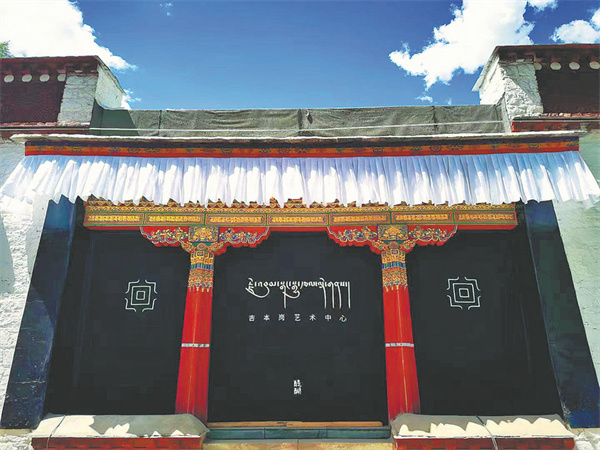
The Jebum-gang Lha-khang temple in Lhasa, Tibet autonomous region, has been transformed into a modern art center. [Photo provided to China Daily]
Xia Yujun still remembers the first time he laid eyes on the Jebum-gang Lha-khang temple in 2016.
"Pushing open the heavy door, one was greeted by a primitive and rustic atmosphere. The dimness inside the hall added a touch of mystery to the architecture itself," the man in his 30s recalls.
"It has a history of approximately 200 years and has murals from the Qing Dynasty (1644-1911)," he adds.
The ancient building's circular construction, ancient Tibetan pillars and verandas, and layers of weathered centuries-old murals were among the highlights that hit him between the eyes.
The temple is tucked away in a bustling business street and residential area, 3,650 meters above sea level, in Lhasa, Southwest China's Tibet autonomous region. First built during the second half of the 19th century, it is the only mandalic building — a symbolic Buddhist symmetrical structure.
It was used as granary for decades, and it is now a popular place among visitors in pursuit of modern art, thanks to five years of efforts by Xia and his team.
The top two stories of the temple were derelict when Xia and his team started the restoration.
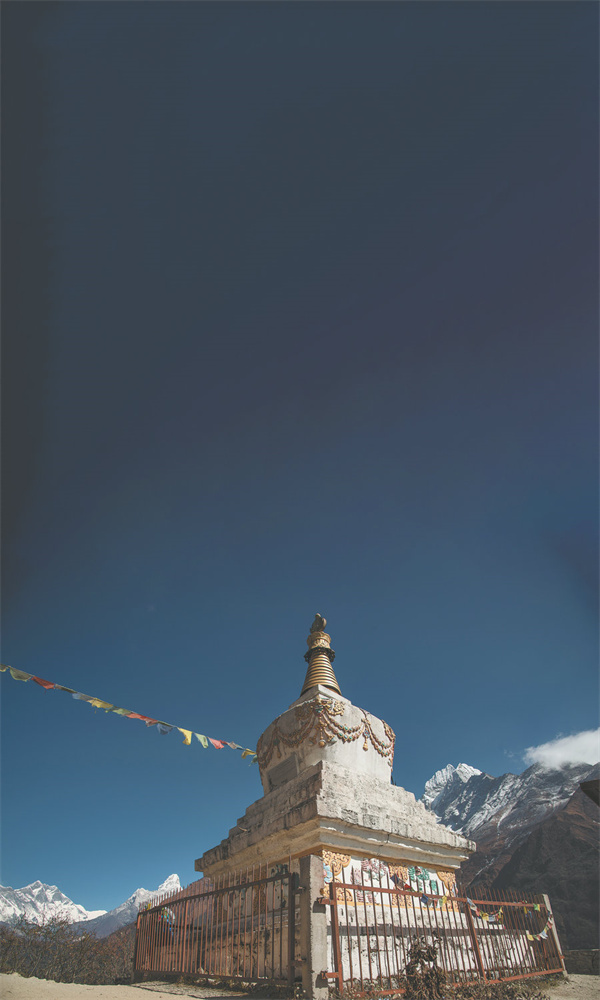
A dagoba Xia encountered during an architectural study tour in Nepal. [Photo provided to China Daily]
Many of the paintings of Buddhist figures were blurry and traces of fire from when the building was burned could be seen on some carved wooden decorations.
In 2015, the local government decided to bring in a group of architects, artists and scholars to restore the ancient building.
Xia says he got off to a rough beginning, since there was no precedent to refer to.
"I probably looked at around 30,000 old photos," Xia says about his efforts to piece together the original details of the temple's past.
"Only by clarifying everything, from the underlying logical relationships to historical heritage and spatial logic, can we have top-level design," he explains.
After the basics of the temple were restored, Xia's team conducted extensive investigations before adding some new functions to make it an art space, without altering the original structure or the spatial flow.
The goal was to bring it back to life, Xia says.
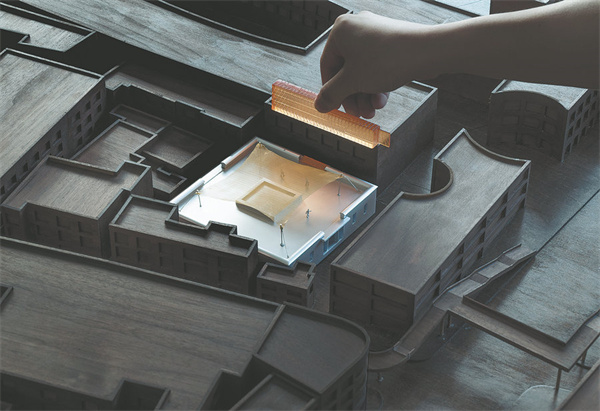
An architectural model of the center. [Photo provided to China Daily]
To transform Jebum-gang Lha-khang into a modern art space, significant improvements were needed, including to its electrical, waterproofing and security systems.
"The infrastructure required almost complete reconstruction," Xia says.
Polyurethane waterproofing materials were first used to seal the gaps in the roof and keep the summer storms from doing further damage to the building.
The work took three weeks, and a three-layer waterproofing system was applied on both the interior and exterior of the roof to ensure that the murals inside would not be affected for the next decade, Xia explains.
Then, old elm-wood flooring was installed using a joist structure, under which the necessary pipeline and electrical systems were embedded, paving the way for sound, lighting and electrical equipment essential to future exhibitions.
The lighting system also underwent significant renovations. The incandescent lights were replaced with special lamps for museum-grade illumination, reducing the harmful rays that could damage the murals. The resulting lighting atmosphere allows viewers to experience the tranquility of this sacred building.
"In this way, a sense of holiness and mystery gradually emerges throughout the entire space," Xia says.
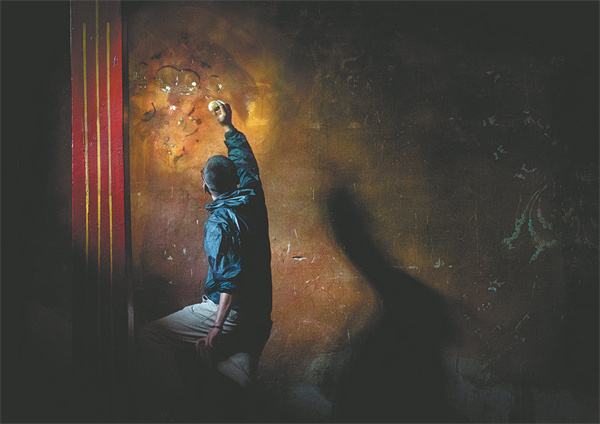
Xia Yujun checks a mural at the center. [Photo provided to China Daily]
Xia and his team have also created a modern corridor made up of 2,000 copper plates, with patterns crafted by local coppersmiths, to have people feel the fusion and collision of tradition and contemporary art from the moment they step into the art center.
Xiao Su from Sichuan province has visited the art center several times.
"It was all a mundane affair with the loud peddlers outside the walls, while there was a beautiful and stunning mural art world inside," Xiao says.
"I also love the art center because it has done a great job handling space, light, artworks and their relations with humans," she adds.
The museum has been open to the public for two years and has packed in visitors on a weekly basis, Xia says.
"Seeing it go from a decrepit ancient building into a popular site with so many people, I feel very accomplished," he adds.
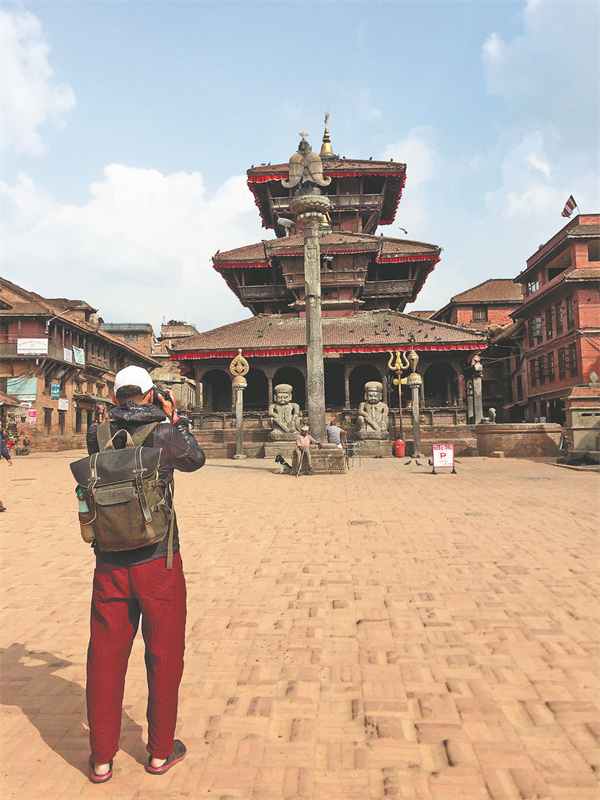
Xia photographing buildings in Nepal, in 2015. [Photo provided to China Daily]
Xia has been fascinated by ancient architecture since childhood. He grew up around the classic Chinese gardens and museums in Suzhou, Jiangsu province. His parents sent him to a local calligrapher's workshop to learn painting in his teenage years.
"My teacher would take me to various museums and take in the picturesque beauty of the ancient architectural wonders in the classic gardens, including the pavilions, towers and courtyards," Xia says about his initial encounter with ancient architecture.
After finishing a degree in architectural design at the Sichuan Fine Arts Institute in Chongqing in 2013, Xia furthered his studies of Himalayan regional architecture at the Birmingham City University in the United Kingdom, before going back to work in Shanghai after graduation in 2015.
He was approached to help restore ancient buildings in Tibet for his expertise in the field.
"I visited the Tibetan region multiple times in college, thanks to its geographical proximity," Xia says.
He still remembers the distinctive historical architecture he saw in Daocheng Yading, a popular tourist destination in the Garze Tibetan autonomous prefecture, Sichuan province, in 2014.
"There were many old buildings left there, all of which were constructed using local materials," he recalls.
"You can see irregular shapes in the stones and wood — not finely processed or in quantifiable shapes. I really appreciate the natural and non-standardized architectural feel, and they possess the most primitive impact," he says.
Xia says he was deeply impressed by the vitality of natural growth conveyed by those buildings.
"This feeling of ancient architecture is completely different from the traditional gardens in my hometown," he says.
Xia's master's thesis focused on ancient architecture in the Himalayas. During these travels, he also transcribed architectural design materials and manuscripts.

Xia grew up around classic architecture in Suzhou, Jiangsu province. [Photo provided to China Daily]
Fascination about Himalayan buildings and Tibetan culture had Xia embark on a new journey to Tibet in 2016.
"Ancient architecture in Tibet is not merely three-dimensional in the eyes of an architect. It's 5D and even 6D, because they have scent, sound, a sense of light and history," Xia says, adding that only when people delve into local clusters of ancient architecture can they truly communicate with these ancient buildings, including magnificent palaces and solemn temples.
"It's like exploring a mystery, so it's very interesting," he says.
He saw the Jebum-gang Lha-khang temple a perfect site to carry out his ambition of integrating Himalayan regional and modern constructions.
"It has been a center of energy for the ancient city of Lhasa and an important carrier of local Tibetan culture," Xia says.
Yet, he found many local residents knew little about the temple, including a local photographer he knows who used to study at the primary school about 50 meters away from it.
That was why Xia and his team decided from the start that the temple should be restored and made a window for both visitors and residents to better appreciate Tibetan culture and art.
Xia recently made a short film recording the ancient building renovation and put it online, with an aim of raising more public awareness of ancient buildings and their protection.
"There are still many idled historical buildings in the ancient cities of Tibet, and we want to find those of great value and help show them in the form of an art center or cultural museum," Xia says.
"This way, I hope young people can pay more attention to ancient building restoration in Tibet and more of them can join in the sector," he says.
In fact, ancient buildings like the temple in this bustling area are few and far between. More of them are hidden off the beaten track.
Therefore, Xia and his team have started to profile more than 1,000 ancient buildings in other parts of the region.
"There is a strong magnetic field here that attracts people who are interested, indicating that this place is connected to the world and always filled with a sense of freshness," Xia says.








